Summary: A complete history of a brake caliper strip and rebuild. The original post was made by Descolada and can be found here. The extract shown here is a summary from the end of the thread where Des summarises his experiences.[s:iv6ldjld]Final report of the commercial starship Nostromo[/s:iv6ldjld] - No, wait, that's something else entirely.
Why did I start this?As many of you will know, I recently undertook an unanticipated rebuild of both the front calipers on my wee AK9, it was the first time I had done this sort of job on any motorbike.
It began as a simple replacement of brake pads on the rear wheel, a job I had been meaning to get round to for many months, but I don't have a garage and the weather did not work in my favour. The driving factor was that I have the bike's second MOT at the end of March and was doubtful that the bike would get through given how low the pads were.
I reminded myself that I purchased a full set of front and back pads some time ago but decided against doing the work at the time, because when I took the pads out and inspected them they just needed a good clean and still had an ample amount of material left on the pads.
Why change them when you don't really need to?
I had at the time asked on the forum and was pointed to EBC HH pads as the best replacements and got them all from Sportsbikeshop.com, FA229HH & FA231HH for the front, FA174HH for the rear.
After removing and cleaning the rear brake caliper, copper greasing what needed to be greased and fitting the new pads I bolted everything back up and thought to myself "It would be stupid to do all this and not look at the front brakes - just to be sure". I wasn't expecting anything too awful because (
thanks to the piles of salt on the roads) I had been washing these off as often as possible with soapy water.
Starting with the nearside caliper I shone my inspection light into the gap between the disc and the caliper and stopped while I did a doubletake. Clearly poking out from the sides of both pistons were the dust seals. I swore loudly and checked the other side - ditto.
The exposed seals.
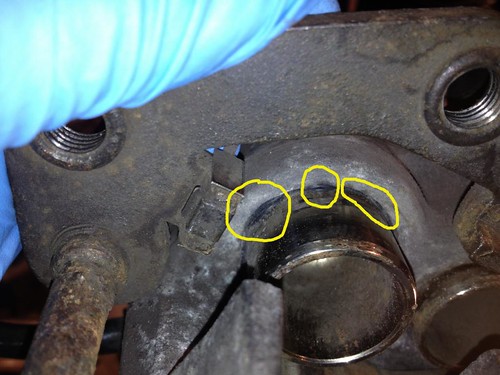
The pads displayed obvious signs of an uneven pad wear suggesting that, (a). the brakes had been like this for some time and (b). the pistons were not retracting fully. A closer inspection and an attempt to move them back into their respective sockets soon showed that the piston on the nearside upper was seized completely and the pistons in the offside caliper were very stiff and slow to retract. As someone else on the forum commented, the seal was probably what was jamming the piston.
I would discover later on the seal wasn't the only thing jamming the caliper.
So on the face of it I was going to need a seal kit for both calipers on the front. I decided to do the job right and replace the bleed nipples, nipple covers, rubber dust covers and those long slider gators on both sides. All these items were available in a kit from eBay marked as
"Suzuki DL650 DL1000 DL650 1000 V-STROM Tokico brake caliper seal repair kit" - what I didn't realise when I clicked the "Buy Now" button was that the seals in this kit were only good for K4-K6 - so I later discovered that they were too big for my K9.
The Seals were too big. The new seal is at the bottom.
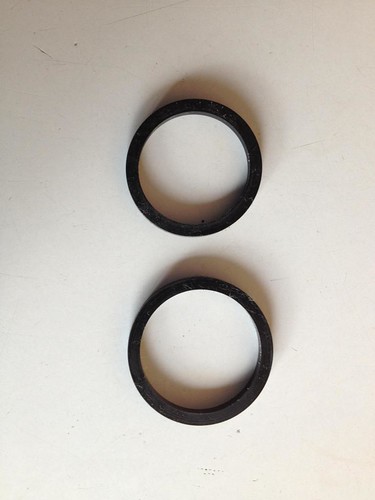
Having removed the nearside caliper I quickly discovered that the "caliper carrier" was entirely seized at the longer pin (the one that goes into the long rubber gaitor). A closer look showed that over time a build-up of salt had pushed the outside of the rubber gaiter in against the slider pin and eventually locked it in place. The surface of the pin itself had been protected from damage by the rubber gaitor, but the hole the gaitor recessed into would need some serious work to restore.
My next challenge was to get the pistons out of the caliper. Trying to twist them out (using pliers with rubber jaw protectors) eventually saw both pistons out but it was a grim struggle and in the end both pistons were so pitted or scratched that they had to be binned.
The next day I started asking about the most reliable place to get pistons and seal kits and started to groan at the prices being advertised. Babel (
forum member) was good enough to point out that Suzuki were running a "
Bike of the Month" discount on parts for the DL650 and amongst that were piston and seal kits I needed (part number: 59300-01820). They were about half the price I had seen elsewhere so I ordered several kits.
Here's where it got a little ugly (
and, eventually, unnecessarily expensive). Everywhere I saw the Suzuki "piston and seal kit # 59300-01820" it appeared to show a single piston and a set of seals. My calipers had twin (
identically sized) pistons on each front caliper - so I ordered two kits for each side. The strange thing about this "bike of the month" deal was that Suzuki do not send these things out directly to the customer. Instead they send them to a registered Suzuki supplier and from there they go to the customer. The order was placed and quite quickly I saw the follow-up email stating that they had been dispatched and would be here in 7-10 days.
7-10 Days!!Well I waited for 7 days and then called Redcar Motorcycles (
because they were the designated supplier). "Ah yes, didn't I call you about that Sir, there was a bit of a problem", Oh here we go I thought. Turns out there was a huge run on that deal and everyone was trying to buy the piston and seal kit (
not surprised when you see the usual price). Indeed, there was so much of a run on them that Suzuki UK ran out of supplies, there were no more to be had. Redcar Motorcycles had a single set that they were about to send out that very day, but no deadline date for when the new supply would be available (
direct from Japan) so no information on where I would see my second set.
Remember that at this point I still believed that each kit contained a single piston and seals and I was still acting under the impression that I would need two kits for each side.
By now the whole thing was beginning to wear a little thin and I decided to call Suzuki Cupar, explain the problem and see if they could suggest an alternative source. They were amazingly helpful, to the extent that they called around and then called me back. The story wasn't good and they could only confirm the information I had been given by Redcar - there appeared to be no supplies at any registered dealer.
On the off chance that someone would have something left on the shelf they provided me with two contacts. Crooks Motorcycles of Barrow-in-Furness and another (
I can't even remember them now). My first call was to Crooks and I was very fortunate to strike gold straight away. The bloke in the parts department had one set left - Yes, it was the right part number and he would just open the box for me to confirm. Yep, two pistons and a seal set (
4 seals). "Wait a minute" says I, "could you please repeat what you just said about the number of pistons in each kit?". He confirmed that by inspecting the contents of the kit.
Two pistons and four seals.The bloke must have thought I had gone barmy because I ended up asking him to confirm that a third time before asking how he would like to be paid. To top it all off he happily matched the price of the deal from Suzuki's "Bike of the Month".
The following morning (
a Friday) the postman arrived carrying my package from Crooks, the day after that the matching package from Redcar arrived. I had a full set - enough to rebuild both calipers on the front of the bike. And that was without having to wait for the extra set to arrive from Japan (
which still hasn't arrived).
Here's what the contents of "Piston and Seal Kit # 59300-01820" look like.
Piston and Seal kit # 59300-01820
 The Rebuild
The RebuildThen began the laborious job of cleaning the calipers back to a condition where they could be remounted on the bike.
I should state that I've mixed up the chronology a little in my telling of this tale. For example, I actually completed the cleaning and respraying of both calipers before the parts arrived, that's mostly how I kept sane while I waited two and a half weeks for the postman to arrive. Keeping busy.
But I think it reads easier if I put it down this way.
I used a mixture of tools in cleaning the calipers and all was done using a
Clarke illuminated magnifying glass (wonderful tool).
The tools list was as follows;
A Dremel multitool and many brass wire brush attachments.
A set of
Maplin Rolson 140mm Needle File SetA Rolson (Maplin again)
12 Part Stainless Steel probe Set - these things were invaluable for getting salt corrosion off the calipers.
A tube of Autosol polish (didn't use this much in the end).
A tub of
Red Rubber greaseA tub of
Copper GreaseA bottle of Halfords DOT4 Brake Fluid.
Plus about a million towels, flanels and swabs.
Here's some of what I was trying to clean up.
Image 1:
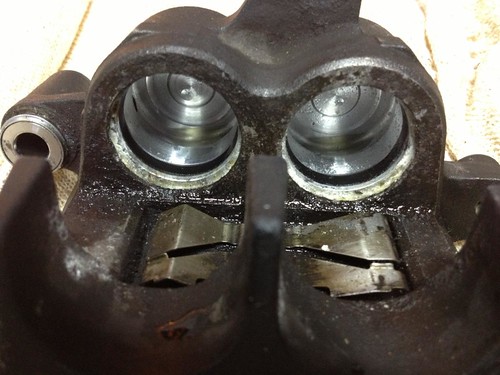
Image 2:
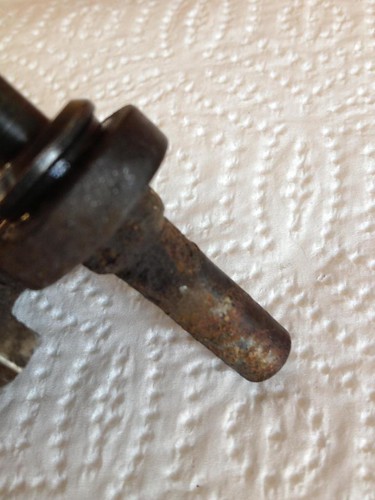
Image 3:

Image 4: This one shows some of the build-up in the seal area.
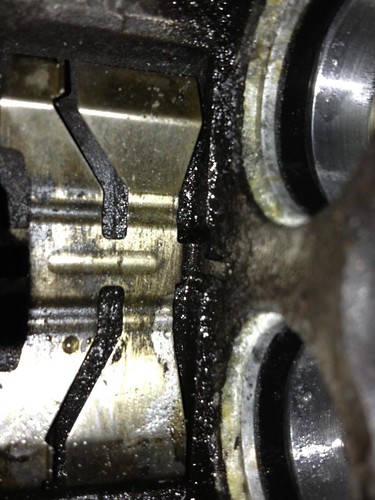
Image 5:
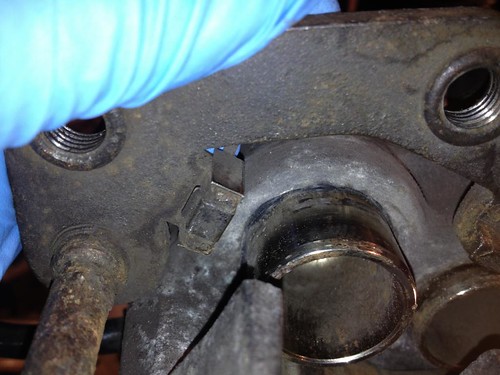
Image 6: And finally, the knackered pistons.
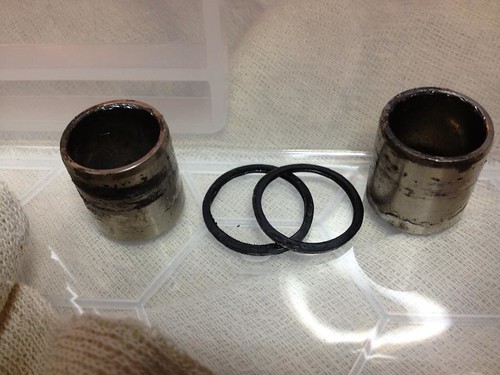
Here's what they started to look like after I had finished my first pass at cleaning the salt deposits off.
Cleaning up begins;
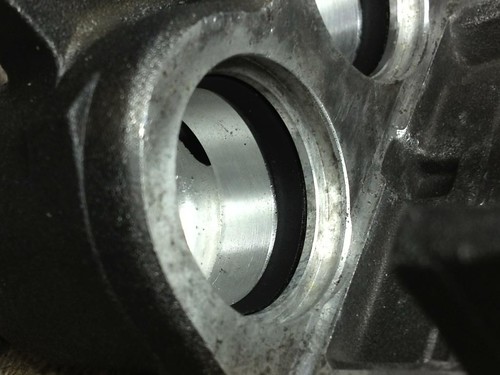 Respraying
ResprayingI decided early on that, so long as I could get the calipers clean enough and could find a colour that matched closely enough (Black is Black, right?), I would add a respray to the rebuild in an attempt to add a little extra protection. I wanted a paint that was hard wearing and resistant to road salt, so I opted to use this stuff;
VHT SATIN BLACK EPOXY PAINT - SP652My wife started getting twitchy again when her Tesco nail varnish remover started going missing as I cleaned the calipers ready for paint.
Much of my work in doing this part went in getting the calipers as clean as possible and masking off the holes and sockets so I didn't get over-spray in places it really shouldn't be. I don't seem to have taken any pictures of this, but it was extensive and a combination of packing with kitchen roll and cut up sections of microfibre cloth where necessary. Everything was then capped off with blue masking tape (
the piston recesses were a bitch to properly cut out and mask).
This spray was very toxic but it was very easy to apply. Two light coats separated by 10 minute breaks and then a 'wet coat' and allow to dry. there is a caution that all this must be completed within the first hour, otherwise additional coats could take
SEVEN DAYS to cure properly. In the end I did four coats per caliper and then allowed 48 hours to cure properly before checking for over-spray. As always, keeping the area and the parts at the correct temperature was critical and achieved with a free-standing halogen lamp.
RebuildingThe rebuild was pretty straight forward, possibly the biggest concern for me was making sure that the seals were installed in the correct orientation or I would end up stripping the whole thing out again when brake fluid came pouring out between the pistons - the first time I squeezed the brake lever. I
really did not want to do that.
I already knew that correctly fitted seals would result in a slightly resistive edge on the furthest-in part of the seal, you can feel it when you drag your finger out of the piston hole. The only problem is that it is very difficult to make out what is the right way to insert these seals until they are in place. You can take them out and try again if you think they are wrong but that means contaminating everything with the red rubber grease you used to lubricate the seal in the first place. You can just make out the edge in this photo.
The Edge of the Seal can just be seen in this picture;
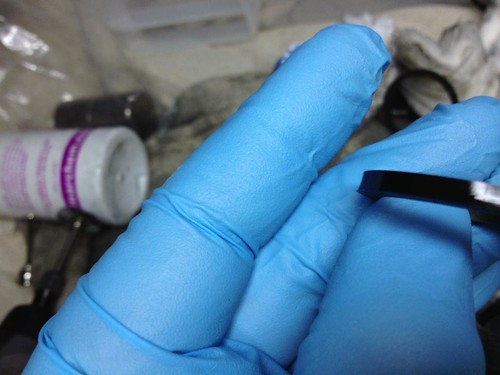
The seals were put back in place after lubricating with red grease and copper grease was used where possible on everything else that needed to move but be protected. The new dust covers and gaitor were also given a liberal coating of red grease and all fittings were tested for correct operation before the final reassembly was completed. Oh, and of course a full set of new pads were fitted.
The piston sockets were cleaned out with new brake fluid as were the nipple socket and banjo bolt socket.
Bleeding AwfulIf I thought that what had gone before was a challenge I was about to get a rude awakening - when I started to bleed the brakes.
The front brake reservoir and brake hoses had been free of brake fluid for over two weeks. Although I had tied back the banjo connectors on both sides and cable tied plastic bags over them, most of the remaining brake fluid had drained out over time into the plastic bags.
I started bleeding out the system and was reassured to see some pretty big belches from the calipers as the new fluid replaced the air in the system. Happy that I was seeing no further bubbles in the system (
and having gone through four full reservoirs of brake fluid), I tried the brake lever for the first time.
It was horrible and very wrong. The lever came all the way back before performing a very soggy stop about an inch (
perhaps less) from the throttle.
So I tried again, twice. Started on one side and bled the system and then moved over to the other. I couldn't understand it because neither side was showing any sign of bubbles and yet the lever remained as bad as before. In something of a panic I posted a request for advice on the forum and
Locky suggested that I tie back the brake lever and leave it overnight in order to give the brake reservoir time to release air back into the reservoir. This I did and the brake lever improved a little, but not as much as I had hoped. Also, the improvement gained by tying back the brake lever faded almost as soon as I started to use the brake lever again.
Greywolf also suggested that the banjo bolts might be trapping air, in particular at the front master cylinder reservoir. I carefully released that banjo bolt and let brake fluid drain out a little before tightening it up again (
the area was covered in cloth to avoid spillage getting on the paintwork), I can't say that I saw much by way of air escaping - but it was worth a try.
After a couple of days of tying back the brake lever I saw a little improvement, but it wasn't enough so I decided the invest in a cheap vacuum bleeder from eBay (
it only cost me £18). I choose this one and waited with baited breath for it to arrive.
Hand Held Reverse Brake Bleed Kit Bleeder Set Vacuum Pump Car Bike Auto TesterThe bleeder finally arrived last Saturday and I was able to get it working quickly (
I will review this product at a later date) and I was stunned when I tried the brake lever again. It was rock solid and back to where I had expected it to be.
To avoid any future bleeding issues I also took Greywolf's advice and purchase a
Banjo Bolt & Bleed Nipple/Screw M10 x 1.25mm - I spoke to the seller to confirm that this was indeed the right size for my bike and searched the forum for threads where the correct size and diameter were discussed. As it happened this arrived along with the brake bleeder on Saturday as well.
So I tested my vacuum bleeder again by draining the front master cylinder reservoir and changing the banjo bolt at that location with the new bleedable version. The vacuum bleeder again performed its magic and the thing was fitted in a very short space of time. The brake lever retained its solid feel.
All was good here and, finally, I was content with the results.Here are a couple of "After" shots.
Image 1: Job Done.
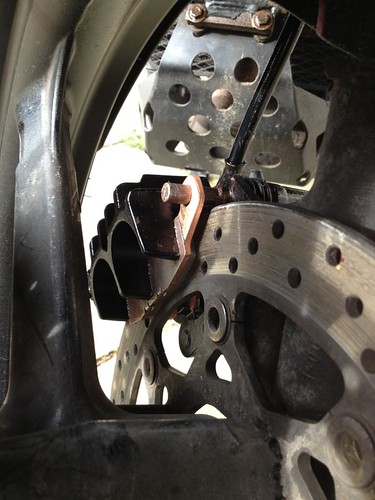
Image 2: A Better look at the Respray;

Everything looks a little shiny in this last picture because ACF50 has been applied to help fend off the Winter weather.
What I learnedAs many pointed out, while this was a painful process to complete, I learnt lots. Among the most important things I learnt were the following;
- Pay close attention to the condition of your brakes, especially during the Winter months. Make sure before you walk away from your bike in the evening that you can still move the caliper a little (you will hear the brake pads clunking as you try to move the caliper once they have been loosened). This will avoid a situation where they bind on overnight and you don't realise it. Remember, if you are riding in the wet or icy conditions and your brakes are binding - you are effectively applying the brakes a little all the time, even when you are taking a corner. Not a healthy state of affairs.
- If you have to strip down your brake caliper(s) make sure to loosen everything before the caliper is off the bike. That way you won't be left struggling to get a bolt or pin loose.
- If you have to replace the pistons in your caliper use the brake lever to push them almost all the way out before you take the caliper off the bike. Be careful not to pop them all the way out because that will end in you emptying the entire contents of your brake reservoir over the bike, the floor or all over you (any one of these results can be combined for greater [read: more horrible] effect). If you end up with sticking pistons and don't use this method you will inevitably end up with a pair of pliers and soon after an unusable set of pistons.
- If at all possible, invest in a vacuum bleeder. Mine was invaluable and yet only cost me £18. If I'd had this when it all went back together and I started the process of bleeding the brakes I have little doubt that the process would have been completed without any of the aforementioned pain.
- I learnt the trick of tying back the brake lever to help trapped air to escape from the system.
- I learnt that the most troublesome place that air will get trapped is in the banjo bolts.
- I reminded myself that this might have gone very differently if I had not had access to the forum and it's wealth of accumulated knowledge.
- Do not assume that Suzuki UK will have large stocks of items may put on "special deals".
- Just because your bike doesn't "qualify" on a Suzuki "Bike of the Month" deal doesn't mean you will fail to complete your purchase on the Suzuki website. I dutifully entered my VIN number and was told that my bike did not qualify for this promotion, but on a hunch I proceeded anyway and completed my purchase without issue.
- Many of these brake parts are common across a good chunk of Suzuki models. Where at all possible try to identify the official part number and look for that rather than the bike model and year.
What I would do differently[1]. I would try to get all the parts I might need collected ahead of time.
[2]. I would try not to panic quite as much when this sort of thing happens, it makes me miserable (
and by osmosis all those around me).
[3]. I would increase the frequency with which I take the brake calipers off my bike and give them a good clean/inspection.
This has been a rather long winded wind-up report, but I'd like to think it might help others by telling the story of what happened to me the first time I stripped down my brake calipers.